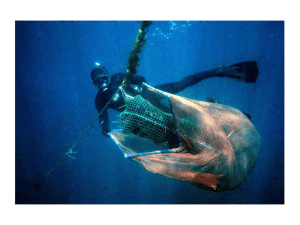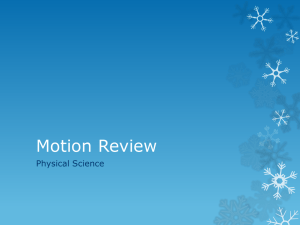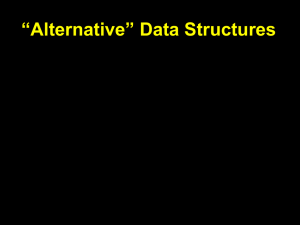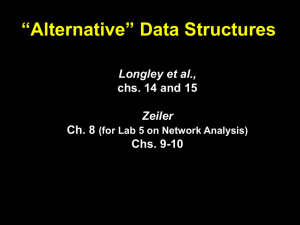Can steepness be estimated in fishery stock assessment models
advertisement
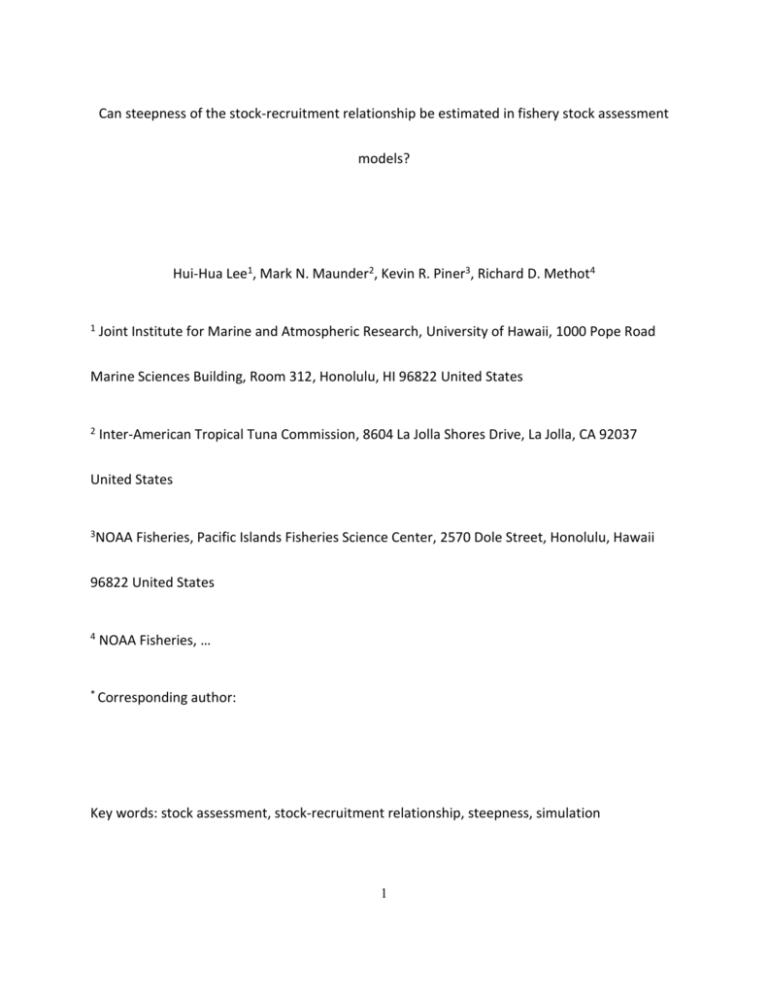
Can steepness of the stock-recruitment relationship be estimated in fishery stock assessment models? Hui-Hua Lee1, Mark N. Maunder2, Kevin R. Piner3, Richard D. Methot4 1 Joint Institute for Marine and Atmospheric Research, University of Hawaii, 1000 Pope Road Marine Sciences Building, Room 312, Honolulu, HI 96822 United States 2 Inter-American Tropical Tuna Commission, 8604 La Jolla Shores Drive, La Jolla, CA 92037 United States 3NOAA Fisheries, Pacific Islands Fisheries Science Center, 2570 Dole Street, Honolulu, Hawaii 96822 United States 4 NOAA Fisheries, … * Corresponding author: Key words: stock assessment, stock-recruitment relationship, steepness, simulation 1 Abstract Steepness of the stock-recruitment relationship is one of the most uncertain and critical quantities in fishery stock assessment and management. Steepness is widely defined as the fraction of recruitment from a virgin population obtained when the spawners are at 20% of the virgin level. Steepness directly relates to the productivity of the stock, the yield that can be obtained, and management reference points. Stock recruitment relationships have traditionally been estimated from time series of recruitment and spawning biomass, but recently interest has arisen regarding the ability to estimate steepness inside fishery stock assessment models. We evaluated the ability to estimate steepness of the Beverton-Holt stock-recruitment relationship using simulation analyses based on 12 groundfish stocks in waters off the US west coast. The simulation results indicate that in most cases steepness was estimated with moderate to low precision (CV 16%) and moderate to high bias ( 10%). A high proportion of steepness estimates from the simulated data and the original data occur at the bounds for steepness (0.2 or 1.0), which results in biased inference. The poorly estimated steepness indicates that there is little information in the data about this quantity. 2 Introduction Stock productivity is the most fundamental issue to quantify in fishery stock assessment and management. Productivity influences stock size, the yield that can be obtained (e.g. maximum sustainable yield), and management reference points (e.g. spawning biomass associated with maximum sustainable yield). When a stock is exploited to low population size, regenerative process of a stock becomes crucial to the recovery of the stock. A common measure of how productivity a stock is at low population size is to determine steepness of the stock-recruitment relationship. Unfortunately, steepness of the stock-recruitment relationship is one of the most uncertain population dynamic quantities and determining it’s value is challenging. The form of stock-recruitment relationship is usually unclear although theory is well developed (BevertonHolt 1957; 1993; Ricker, 1954) and has been used to provide management advice. Part of the inability to detect a relationship is the large amount of variability in recruitment caused by factors other than spawner abundance and information on recruitment is typically scarce. In the majority of stock assessments, steepness is not based on reliable data from the stock being assessed, but is chosen by experts (e.g. Maunder and Aires-da-Silva, 2008; Aires-da-Silva and Maunder, 2008), borrowed from other stocks or species (e.g. using meta-analyses; Myers et al., 3 1999; Myers et al., 2002; Dorn, 2002), or based on life history theory (Mangel et al., 2009). However, bias may occur in the chosen value because both recruitment values and the spawner values have error, selected stocks may not be representative, and environmental factors may have influence on recruitment. Recently, interest has arisen regarding the ability to estimate steepness inside the stock assessment model. Estimating the parameters inside the stock assessment automatically accounts for the different levels of error in recruitment and spawners. For example, one can incorporate both observation error and process error into the relationship. Also, estimating the parameters inside the stock assessment model allows the stock recruitment curve to inform the model about levels of recruitment for which there is little information in the data. The purpose of this paper is to evaluate the reliability of stock-recruitment steepness estimates from fishery stock assessment models. We use simulation analysis based on existing peer reviewed stock assessment models. By analyzing many populations with identical methods, it is possible to arrive at conclusions of greater generality. 4 Methods The assessment model Stock assessment models (data and assessment model definition files) were obtained for 12 Pacific Coast groundfish stocks (Table 1). These assessments were conducted using the fully integrated stock assessment model, Stock Synthesis II (SS2, Rick Method, NMFS), and rigorously reviewed by panels of independent experts for use by the Pacific Fishery Management Council. The twelve assessments had wide range of parameterizations (Table 2) and characterized a wide range of stock characteristics (e.g. productivity; Figure 1). Simulation model Simulation analyses were conducted to evaluate the ability to estimate steepness (h) within these assessment models. The same fishery systems including model assumptions, parameter estimates, and available data used in the peer-reviewed assessments were applied in the simulation analyses (Table 2). By using the same version of the Stock Synthesis program as a simulator, 500 simulated data sets were generated based on characteristics of the real data and the likelihood functions used in the stock assessment. In order to avoid potential bias in the process error, annual recruitment deviates were randomly generated under assumption of the same variability as stock assessment model and were added into the stock-recruitment relationship. These simulated data sets were then fitted to the model with the alternative 5 hypothesis of estimated steepness with no prior information. Simulated data sets that produced estimates with a maximum gradient >1 were conservatively considered to have convergence problem and removed from the analysis. The performance of a simulation model was quantified by comparing the estimates from the 500 simulated data sets with the true value from the assessment model, using the bias of estimators: ˆ Median bias = median where ˆ is the estimated value of steepness and is the true value. The median bias is used to make the performance indicator robust to outliers. Other performance indicators are proportion of estimates at the bounds (failure rate) and variability (coefficient of variation) of estimates that capture both bias and imprecision. A simulation model that performs well has median bias close to 0 and failure rate close to 0 with small cv of estimates. In order to illustrate if data in total or each likelihood component was informative about h, profile likelihood was computed over a then entire range from 0.2 to 1.0 for each likelihood component as well as the total likelihood. If a negative log-likelihood profile shows a concave curve with well defined minimum, this component is informative about steepness. Conversely, the lack of a well defined minimum would suggest a lack of information about h. 6 Finally, we also estimated the steepness from the original data for each stock and compared the results with the results from the simulation analysis. Results Although the maximum gradient of the model fit varied within and between assessments, a moderately high proportion of data sets were retained for all assessments except hake (Table 3). Among these selected data sets, most assessments showed a large failure rate (i.e. proportion of h estimates at either upper bound of 1.0 or lower bound of 0.2) except blue rockfish, sable fish, and yellloweye rockfish (Table 3). This result suggested that estimates of h were biased given our data sets (Table 4). A summary of the results based on the unbiased estimates revealed that h was estimated with low precision (CV 17%, Table 4). The exception was yelloweye rockfish with 0% of failure rate. Also, there was no consistent direction to the bias among stocks (Figure 2). Most estimates of h (Figure 2) from the original data were at the parameter bounds (arrowtooth flounder, black rockfish north, blue rockfish, canary rockfish, chilipepper rockfish, and shortbelly rockfish), close to the bound (black rockfish south) or outside the range of uncertainty (hake and yelloweye rockfish). The poorly estimated h in most assessments indicated that available data did not contain sufficient information about h to reliably guide 7 model estimates. However, in the cases of darkblotched rockfish, english sole and sable fish, the estimates of h from the original data were inside the range of uncertainty from the simulations and the estimates were close to assumed values. It is also noted that some assumed values were based on initial fits to the data (darkblotched rockfish, english sole, hake and sable fish; Table 1). The results of the profile likelihoods suggested that in most cases neither individual data types nor all data taken together provided substantial information regarding the value of steepness. The exceptions were darkblotched rockfish, english sole and sable fish which had likelihood profiles of some individual likelihood components as well as the total likelihood which indicated significant information on the magnitude of h. Table 5 summarizes comparison of profile likelihood among the twelve assessments. Discussion In this paper, we have shown, using simulation analysis, how estimation of the steepness of the Beverton-Holt stock-recruitment model performs in the fully integrated stock assessment models. By analyzing many ground fish population, the overall conclusion can be drawn that h of the Beverton-Holt stock-recruitment model is generally estimated imprecisely 8 inside the stock assessment model. A lack of informative data on steepness is the most likely explanation of the inability to estimate this quantity. The advantages of utilizing this set of peer-reviews assessment models were that various types of data were used, over a wide range of model parameterization. Because all models were constructed using versions of SS, the fundamental assumptions of each model can be compared quite easily. The general life histories of many of the stocks represented by the assessment also represented a broad range. From highly productive flatfishes to relative unproductive and long lived rockfishes. For example, the pattern of recruitment for yelloweye rockfish indicates that stock productivity is low (i.e. week year-classes at low levels of spawning biomass) but stock productivity for darkblotched rockfish appears to be moderate (i.e. the relative strong year-classes at low levels of spawning biomass). The irrelevance or the inability to estimate the stock-recruitment relationship is apparent in some flatfish species (e.g. arrowtooth flounder), which have large annual recruitment variability and/or little information at low population size. There may be additional error in the assessment model beyond that incorporated into standard deviation of the recruitment residuals and sampling error represented by the likelihood functions. For example, yelloweye rockfish has symmetric distribution of estimates 9 with reasonable variability (11% CV) but estimates of steepness from the original data laid outside the range of uncertainty. This error might come from confounding parameters, recruitment trends caused by the environment, and model misspecification. Natural mortality, steepness and selectivity are known as highly confounded parameters (Thompson, 1994; Magnusson and Hilborm, 2007). Hake performed poorly partly due to estimating natural mortality and steepness simultaneously. Our initial diagnostic for yelloweye rockfish suggested that there might be process error in the assumed recruitment deviations (results not shown in the paper). It is noted that there may not be a simple cause and evaluation of model misspecification is beyond the scope of this study. This study indicated that h is difficult to estimate reliably across a fairly broad range of parameterizations, life histories and population dynamics. However Magnusson and Hilborn (2007) concluded that steepness was estimated with some reliability when abundance-index or age-composition data were available from years of very low abundance. Our investigation also found that including indices of abundance with trajectories that were either decreasing or rebuilding in years of very low abundance provided information h (darkblotched rockfish and sable fish). Good recruitment success at low spawning stock levels does appear to have information about the shape of the stock-recruitment curve (Ricker, 1958). Although with the 10 appropriate data there appears to be information about h, the reliability of the estimates remains questionable. Reference points and rebuilding strategies are directly dependent upon the shape of the stock recruitment relationship (Maunder 2003; more refs). Ianelli (2002) found that reference points are overestimated when the true h of the stock-recruitment curve is lower than assumed, and underestimated when the true value of h is higher. Maximum sustainable yield is a monotonically increasing function of steepness and spawning biomass associated with maximum sustainable yield is a monotonically decreasing function of steepness. The influence of determining steepness on management quantities varies with species (Fig. 3). Therefore, the influence of steepness of the management advice should be evaluated for each stock being assessed through comprehensive sensitivity analysis. This is particularly true if a higher steepness value is used as it may potentially result in an overly optimistic assessment of stock status. Based on these results our analysis suggests that steepness should not be estimated inside the stock assessment model, but fixed values or informative priors be used. Dorn (2002) proposed a hierarchical Bayesian approach and Mangel et al. (2009) incorporated biological and ecological characteristic of species to construct a prior distribution for steepness. Although, 11 with the appropriate data collected at the right population sizes h may be estimable, common sense should be applied to any resulting estimates. Acknowledgements Our sincere thanks to the stock assessment authors at the Northwest Fisheries Science Center and Stacey Miller for providing copies of their stock synthesis files, which greatly facilitated this study. We are also grateful to the Southwest Fisheries Science Center for supporting HH-L and KRP during most of this work. 12 Reference Aires-da-Silva, A. and M.N. Maunder. 2008. Status of bigeye tuna in the Eastern Pacific Ocean 2008 and outlook for the future. Inter-Amer. Tropical Tuna Commission Stock Assessment Report SARM-10-06b. http://iattc.org/PDFFiles2/SARM-10-06b-BET-assessment-2008.pdf Beverton, R.J.H. and Holt, S.J. 1957/1993. On the Dynamics of Exploited Fish Populations. Chapman and Hall, London. Dorn, M.W. 2002. Advice on West coast rockfish harvest rates from Bayesian meta-analysis of stock-recruit relationships. North American Journal of Fisheries Management 22: 280-300. Ianelli, J.M. 2002. Simulation analyses resting the robustness of productivity determinations from West Coast Pacific Ocean perch stock assessment data. North American Journal of Fisheries Management 22:301–310. Mangel, M., J. Brodziak and G. DiNardo. 2009. Reproductive ecology and scientific inference of steepness: a fundamental metric of population dynamics and strategic fisheries management. Fish and Fisheries. 8: 337–358. Magnusson, A. and R. Hilborn. 2007. What makes fisheries data informative? Fish and Fisheries. 8: 337–358. Maunder, M.N. (2003) Is it time to discard the Schaefer model from the stock assessment scientist’s toolbox? Fisheries Research, 61: 145-149. Maunder, M.N. and A. Aires-da-Silva. 2008. Status of yellowfin tuna in the Eastern Pacific Ocean 2008 and outlook for the future. Inter-Amer. Tropical Tuna Commission Stock Assessment Report SARM-10-06a. http://iattc.org/PDFFiles2/SARM-10-06a-YFT-assessment-2008.pdf Myers, R.A, K.G. Bowen, and N.J. Barrowman. 1999. Maximum reproductive rate of fish at low population sizes. Can. J. Fish. Aquat. Sci. 56: 2404-2419. 13 Myers, R.A., N.J. Barrowman, R. Hilborn, and D.G. Kehler. 2002. Inferring Bayesian priors with limited direct data: Application of risk analysis. North American Journal of Fisheries Management 22:351-364. Ricker, W.E. 1954. Stock and recruitment. J. Fish. Res. Board Can. 11, 559–623. Ricker, W.E. 1958. Handbook of computations for biological statistics of fish populations. Bulletin of the Fisheries Board of Canada 119, 300 pp. Thompson, G.G. 1994. Confounding of Gear Selectivity and the Natural Mortality Rate in Cases where the Former is a Nonmonotone Function of Age. Can. J. Fish. Aquat. Sci. 51(12): 2654– 2664. 14 Table 1. Source of the twelve groundfish assessments used in this study. Species Arrowtooth Assessment report Stock assessment of the arrowtooth flounder (Atheresthes stomias) population off the West Coast of the United States in 2007 Isaac C. Kaplan and Thomas E. Helser Black RF_N Status of the black rockfish resource North of Cape Falcon, Oregon to the U.S.-Canadian border in 2006 Farron R. Wallace, Yuk Wing Cheng, and Tien-Shui Tsou The Status of Black rockfish off Oregon and California in 2007 Black RF_S David B. Sampson The 2007 assessment of blue rockfish (Sebastes mystinus) in California Blue RF Meisha Key, Alec D. MacCall, John Field, Debbie Aseltine-Neilson and Kirk Lynn Status of the U.S. Canary rockfish resource in 2007 Canary Ian J. Stewart Status of the chilipepper rockfish, Sebastes goodei, in 2007 Chilipepper John C. Field Darkblotched Status and future prospects for the darkblotched rockfish resource in waters off Washington, Oregon, and California as assessed in 2007 Owen S. Hamel Englishsole Updated U.S. English sole stock assessment: status of the resource in 2007 Ian J. Stewart Hake Stock assessment of Pacific hake, Merluccius productus, (a.k.a Whiting) in U.S. and Canadian waters in 2008 Thomas E. Helser, Ian J. Stewart, and Owen S. Hamel 15 Sable Status of the sablefish resource off the continental U.S. Pacific Coast in 2007 Michael J. Schirripa Shortbelly Stock assessment model for the shortbelly rockfish, Sebastes Jordani, in the California current John C. Field, Edward J. Dick, and Alec D. MacCall Yelloweye Update to the status of yelloweye rockfish (Sebastes ruberrimus) off the U.S. West Coast in 2007 John R. Wallace 16 Table 2. The twelve assessment models in terms of data types used and parameters estimated. Arrowtooth Black RF_N Black RF_S Blue RF Canary Chilipepper Darkblotched Englishsole Hake Sable Shortbelly Yelloweye Data Catch X X X X X X X X X X X X Indices (survey) X X X X X X X X X X X X X X Discard Age data Length data X Age-length X Mean length-at-age X X X X X Mean body-weight X X X X X X X X X X X X X X X X X X X X X X X X X X Estimated R0 X X X X M X X X X X X X X Lsd At least one q estimated X X X X X X X X X h G X X X X X X X X X X X X X X X X X X X X X 17 X X At least one asymptotic selectivity X X X X X X 18 X X X X X Table 3. Proportion of data sets used (gradient < 1) in summarizing results based on the maximum gradient less than one. The failure rate is the proportion of these useful data sets at the bounds of estimates. Proportion useful Failure rate Arrowtooth 0.89 0.56 BlackRF_N 0.88 0.19 BlackRF_S 1.00 0.43 BlueRF 1.00 0.06 Canary 0.99 0.28 Chilipepper 0.85 0.26 Darkblotched 1.00 0.22 Englishsole 0.79 0.42 Hake 0.34 0.60 Sable 0.99 0.01 Shortbelly 1.00 0.17 Yelloweye 0.76 0.00 19 Table 4. Average, coefficient of variation (cv) and median bias of estimates from the simulation analysis based on the maximum gradient less than one (useful estimates). Unbiased estimates are defined as useful estimates that did not occur at the bounds. The median bias represents tendency of estimates towards the true value from the assessment model. average cv median bias (in percent) useful estimates unbiased estimates useful estimates unbiased estimates useful estimates unbiased estimates Arrowtooth 0.90 0.77 0.16 0.18 0.11 -0.11 BlackRF_N 0.61 0.52 0.39 0.31 -0.11 -0.21 BlackRF_S 0.75 0.57 0.34 0.32 0.37 -0.12 BlueRF 0.67 0.65 0.20 0.17 0.10 0.09 Canary 0.69 0.57 0.32 0.25 0.19 0.05 Chilipepper 0.73 0.63 0.27 0.20 0.18 0.10 Darkblotched 0.68 0.61 0.26 0.21 0.07 -0.02 Englishsole 0.86 0.76 0.18 0.17 0.14 -0.04 Hake 0.81 0.52 0.34 0.42 0.20 -0.45 Sable 0.40 0.40 0.30 0.25 -0.13 -0.13 Shortbelly 0.39 0.32 0.63 0.39 -0.55 -0.56 Yelloweye 0.54 0.54 0.11 0.11 0.20 0.20 20 Table 5. Likelihood comparison from profile log-likelihood analysis across range of steepness (0.2-1.0) for the twelve assessment models. If a negative log-likelihood profile has a concave curve shape with well-defined minimum, likelihood component is informative about steepness (denoted by plus signs). Minus signs represent that likelihood component is uninformative and blank represent that data is not available. Likelihood component Arrowtooth Black RF_N Black RF_S Total - - - Indices (survey) - - + Blue RF Canary Chilipepper Darkblotched Englishsole Hake Sable Shortbelly Yelloweye - - - + + - + - - - + - + - - + - + - - Discard + Length comps - - - + - - - - - - - - Age comps - - - - + - + - - + - - - - Size-at-age Mean body-weight - - - + informative about steepness - uninformative about steepness 21 - + Figure 1. Three examples of stock-recruitment estimates from groundfish stock assessments showing different levels of stock productivity (Top: low productivity for yelloweye rockfish; Middle: moderate productivity for darkblotched rockfish; Bottom: high productivity for arrowtooth flounder). The productivity of stock can be determined by pattern of recruitment at low levels of spawning biomass. 22 Figure 2. Distribution of steepness estimated from the simulation data in which unbounded estimates of steepness were used. Dashed lines represent true/assumed values of steepness from original assessments. Dots represent estimated values of steepness from original data sets and bold dash lines represent confidence intervals around estimates. 23 Figure 3. The relationship between steepness values and spawning biomass associated with maximum sustainable yield (SPBMSY) from original assessments. Estimates are not available for shortbelly rockfish. 24




